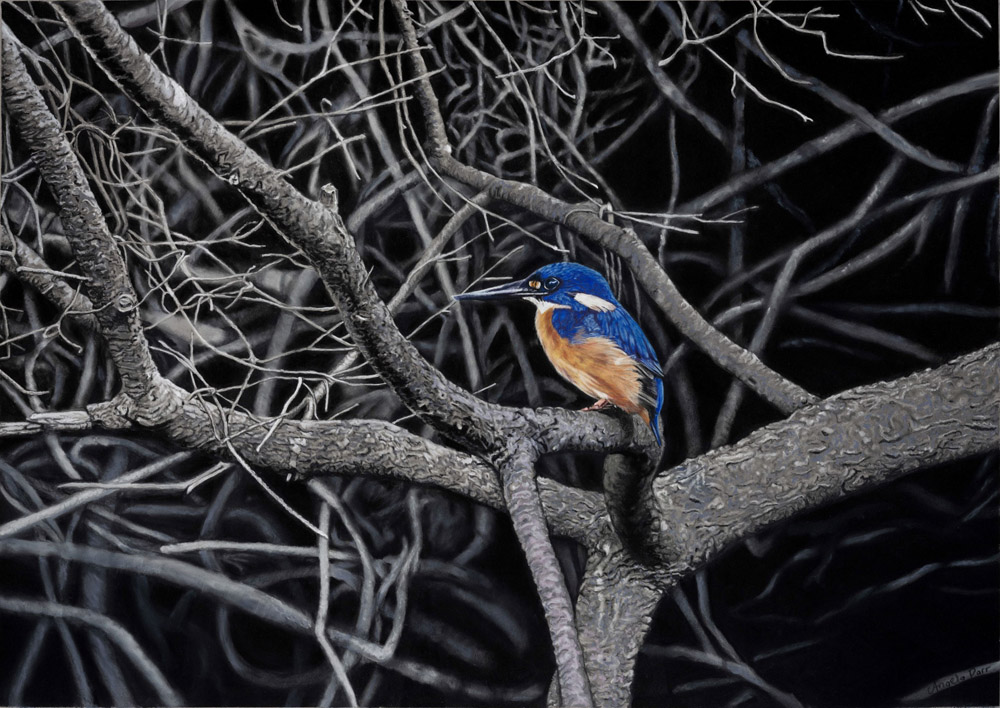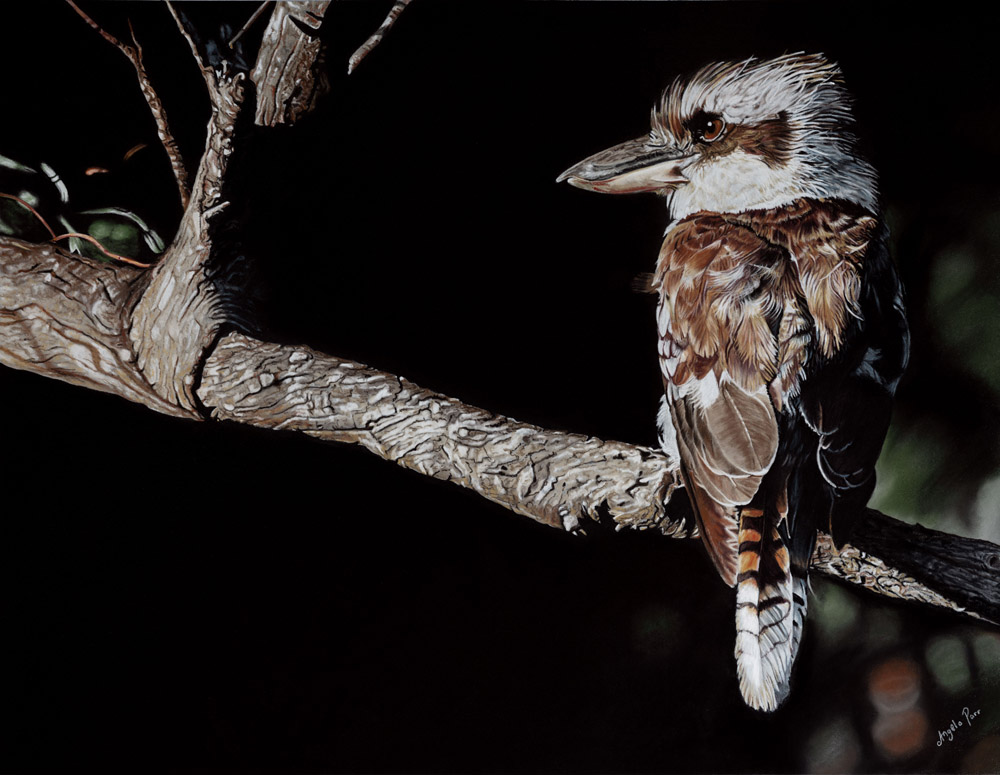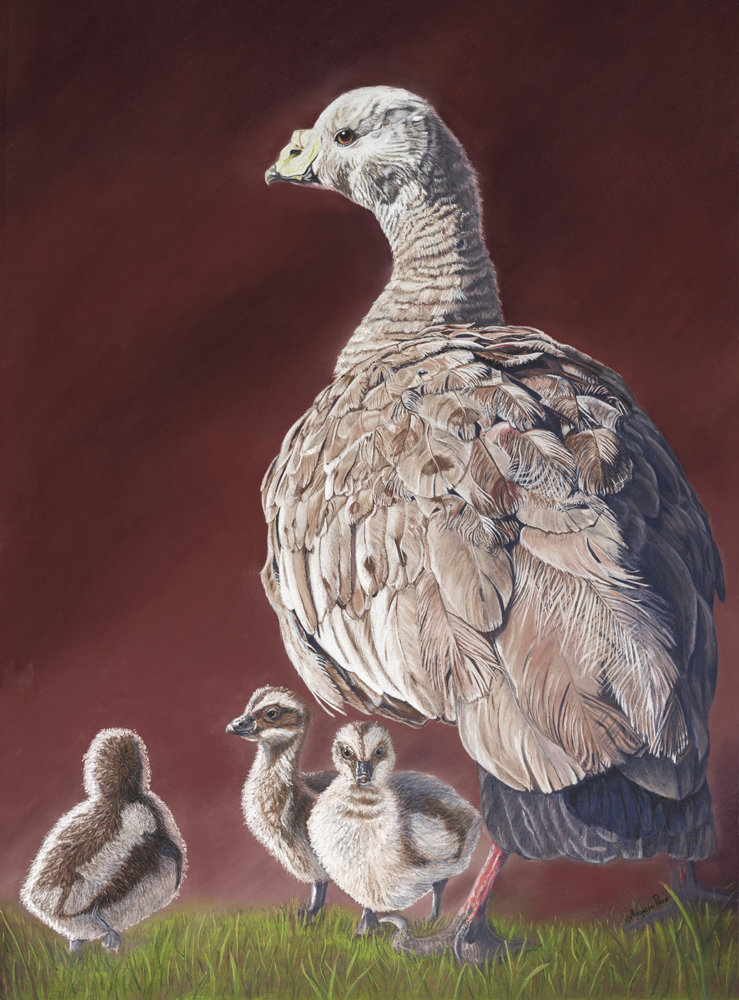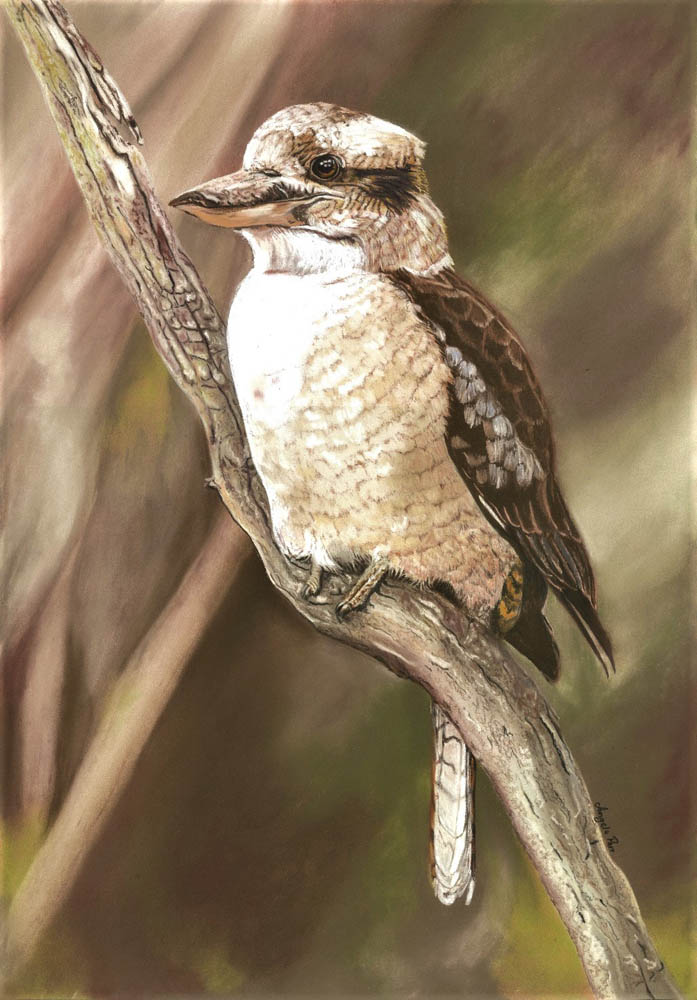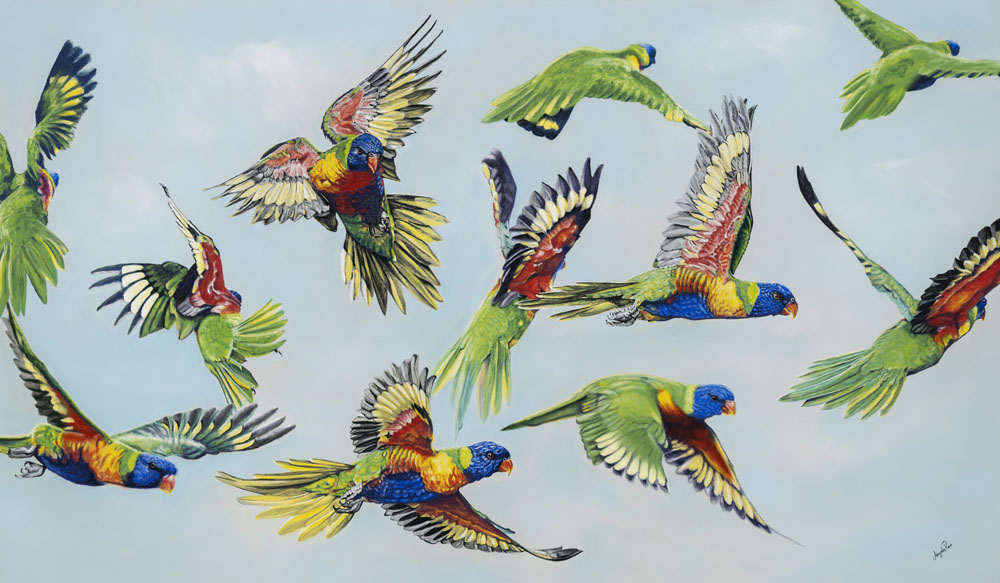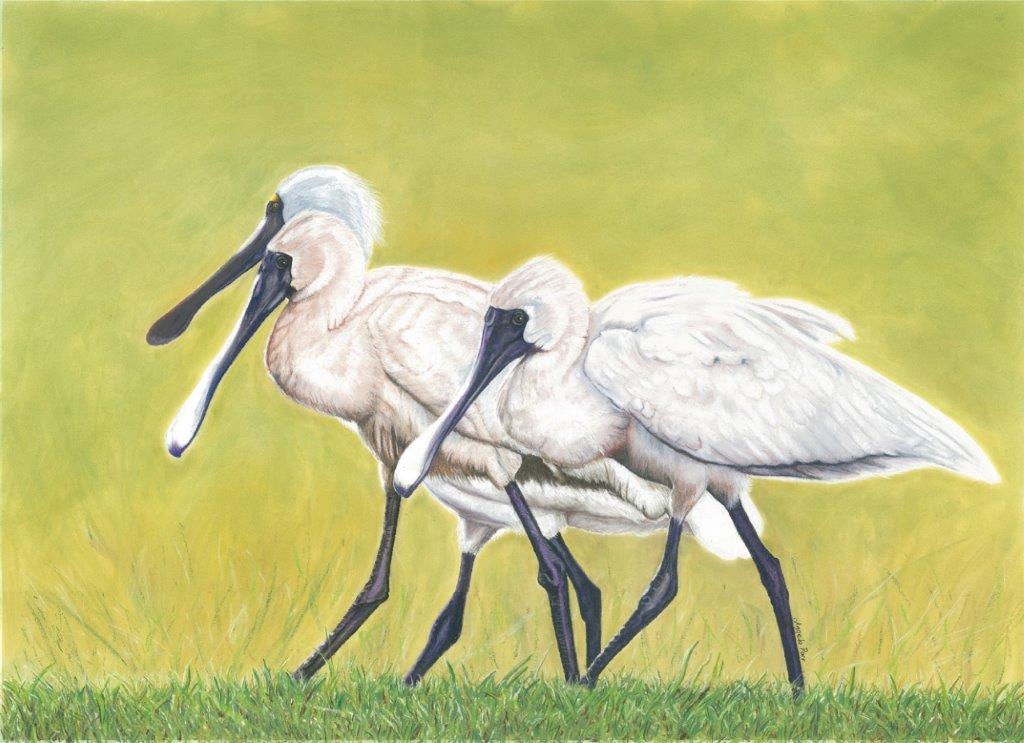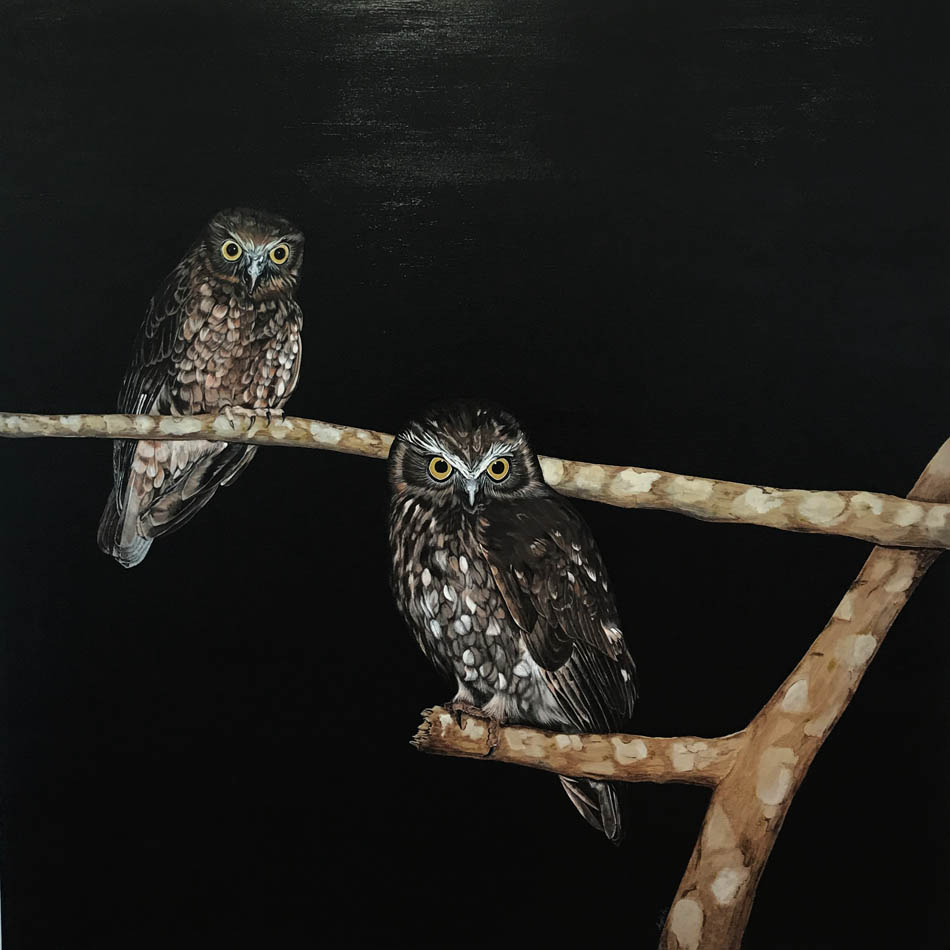Birds
-

Damn! Forgot My Spoon
Pastel on Pastelmat Card ($POA)
The royal spoonbill (Platalea regia) also known as the black-billed spoonbill, occurs in intertidal flats and shallows of fresh and saltwater wetlands in Australia, New Zealand, Indonesia, Papua New Guinea, and the Solomon Islands. It is a wading bird and has long legs for walking through water. Spoonbills are characterized by their spoon-shaped bills, which they use to sweep through the water to catch prey. It eats fish, shellfish, crabs and amphibians, catching its prey by making a side-to-side movement with its bill. Ibises, also have long legs and long necks, but on the other hand have long, curved beaks used for probing in the mud for food. They are however the closest relative spoonbills have. Both Ibis and Spoonbills are excellent indicators of wetland health.
Read moreDamn! Forgot My Spoon
Pastel on Pastelmat Card ($POA)
The royal spoonbill (Platalea regia) also known as the black-billed spoonbill, occurs in intertidal flats and shallows of fresh and saltwater wetlands in Australia, New Zealand, Indonesia, Papua New Guinea, and the Solomon Islands. It is a wading bird and has long legs for walking through water. Spoonbills are characterized by their spoon-shaped bills, which they use to sweep through the water to catch prey. It eats fish, shellfish, crabs and amphibians, catching its prey by making a side-to-side movement with its bill. Ibises, also have long legs and long necks, but on the other hand have long, curved beaks used for probing in the mud for food. They are however the closest relative spoonbills have. Both Ibis and Spoonbills are excellent indicators of wetland health.
Quick View -
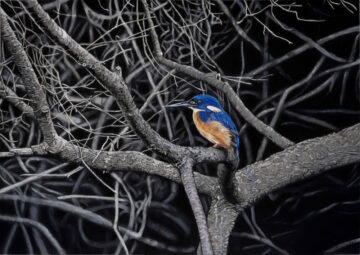
In the Forest Deep and Dark
Pastel on Pastelmat Board ($POA)
Image size 47cm h x 56 cm w
Framed 83 cm h x 65 cm w
The Azure Kingfisher is found across northern and eastern Australia, almost always above water. It patrols up and down waterways and rivers from perch to perch flying very fast, and only a few meters off the water, typically making a loud high pitched “seeeeeeeep” call. They are very defensive of their breeding territory and form monogamous pairs. Their nests are hidden away at the end of a burrow, dug out of soil in riverbanks. Both parents incubate and feed the chicks. This pastel artwork captures an Azure Kingfisher in a fragile eco-system, a deep and dark mangrove forest. My artwork has contrasted a monochrome background with the bright blues of the bird, thereby focusing on it and the purity of its environment, hoping to elicit in the viewer an urgent need to protect our critical coastal habitats for future generations.Read moreIn the Forest Deep and Dark
Pastel on Pastelmat Board ($POA)
Image size 47cm h x 56 cm w
Framed 83 cm h x 65 cm w
The Azure Kingfisher is found across northern and eastern Australia, almost always above water. It patrols up and down waterways and rivers from perch to perch flying very fast, and only a few meters off the water, typically making a loud high pitched “seeeeeeeep” call. They are very defensive of their breeding territory and form monogamous pairs. Their nests are hidden away at the end of a burrow, dug out of soil in riverbanks. Both parents incubate and feed the chicks. This pastel artwork captures an Azure Kingfisher in a fragile eco-system, a deep and dark mangrove forest. My artwork has contrasted a monochrome background with the bright blues of the bird, thereby focusing on it and the purity of its environment, hoping to elicit in the viewer an urgent need to protect our critical coastal habitats for future generations.Quick View -
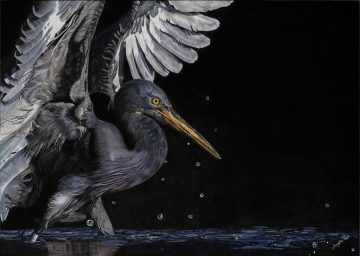
Reef Raider
Pastel on Pastelmat Board (Sold)
Image size 42 cm H x 60 cm W.
Framed 61 cm H x 78 cm WFlat Rock is exactly as it sounds, a large flat rocky outcrop between two beaches in the Ballina Shire. It is a haven for seabirds, both local and migratory, and they know they are safe there. This Pacific Reef Egret (also known as Eastern Reef Egret, and Pacific Reef Heron) was busy fishing in the early morning, wading through one of the many shallow pools.
Having lived in this area since 1982, I often walk these beaches enjoying the beautiful sights here. I just love the drama in this image and hope my artwork has conveyed this.Read moreReef Raider
Pastel on Pastelmat Board (Sold)
Image size 42 cm H x 60 cm W.
Framed 61 cm H x 78 cm WFlat Rock is exactly as it sounds, a large flat rocky outcrop between two beaches in the Ballina Shire. It is a haven for seabirds, both local and migratory, and they know they are safe there. This Pacific Reef Egret (also known as Eastern Reef Egret, and Pacific Reef Heron) was busy fishing in the early morning, wading through one of the many shallow pools.
Having lived in this area since 1982, I often walk these beaches enjoying the beautiful sights here. I just love the drama in this image and hope my artwork has conveyed this.Quick View -

Scarlet Honeyeater
Pastel on Pastelmat Board ($POA)
Image size 46 cm H x 66 cm W
The tiny Scarlet Honeyeater’s range extends along the east coast of Australia. As with most Australian birds, the male is the showier of the two, with brilliant red coloration on the face and back. The female, in contrast, is pale brown-grey.
This is no doubt to protect her, and her offspring in the nest, by being less obvious for predators. My artwork is aimed to highlight her petite beauty, as she props within a flourish of red grevillea, in the Northern Rivers area of NSW, awaiting a male to enthusiastically call out to her.Read moreScarlet Honeyeater
Pastel on Pastelmat Board ($POA)
Image size 46 cm H x 66 cm W
The tiny Scarlet Honeyeater’s range extends along the east coast of Australia. As with most Australian birds, the male is the showier of the two, with brilliant red coloration on the face and back. The female, in contrast, is pale brown-grey.
This is no doubt to protect her, and her offspring in the nest, by being less obvious for predators. My artwork is aimed to highlight her petite beauty, as she props within a flourish of red grevillea, in the Northern Rivers area of NSW, awaiting a male to enthusiastically call out to her.Quick View -

She Contemplates
Pastel on Pastelmat Board ($POA)
Image size 45cm h x 58 cm w
Framed 63 cm h x 76 cm w
Kookaburras are the unique and much-loved sound of the Australian bush. Despite being “boofy- headed”, they are still considered very handsome birds with an intelligent eye. They have a strong beak and a compact body covered in a beautiful array of whites, browns, and blacks. Who wouldn’t love them? This female was captured in the failing light just outside Lismore, northern NSW, presumably contemplating her next meal. Her peaceful demeanour lent itself to a serene portrait using dramatic lighting for highlighting purposes.Read moreShe Contemplates
Pastel on Pastelmat Board ($POA)
Image size 45cm h x 58 cm w
Framed 63 cm h x 76 cm w
Kookaburras are the unique and much-loved sound of the Australian bush. Despite being “boofy- headed”, they are still considered very handsome birds with an intelligent eye. They have a strong beak and a compact body covered in a beautiful array of whites, browns, and blacks. Who wouldn’t love them? This female was captured in the failing light just outside Lismore, northern NSW, presumably contemplating her next meal. Her peaceful demeanour lent itself to a serene portrait using dramatic lighting for highlighting purposes.Quick View -

The Reds
Pastel on Pastelmat Board ($POA)
Image size 80 cm h x 60 cm w
Framed 100 cm h x 78 cm w
I recently spent time in Western Australia where these stunning Forest Red Tails reside. Sadly they are critically endangered due to losses of native habitat, car strikes, nesting competition, animal attacks, and poaching.
They mate for life, sometimes over 50 years, but as they breed slowly, just one young every second year, increasing the species’ numbers has proven difficult.
Their distinctive screech gave them their Noongar name, the Karrak, and is also old bush-lore indicating rain is coming. To see them fly overhead is an absolute privilege, and I hope to have paid homage to their beauty in my artwork.Read moreThe Reds
Pastel on Pastelmat Board ($POA)
Image size 80 cm h x 60 cm w
Framed 100 cm h x 78 cm w
I recently spent time in Western Australia where these stunning Forest Red Tails reside. Sadly they are critically endangered due to losses of native habitat, car strikes, nesting competition, animal attacks, and poaching.
They mate for life, sometimes over 50 years, but as they breed slowly, just one young every second year, increasing the species’ numbers has proven difficult.
Their distinctive screech gave them their Noongar name, the Karrak, and is also old bush-lore indicating rain is coming. To see them fly overhead is an absolute privilege, and I hope to have paid homage to their beauty in my artwork.Quick View -

My Favourite Colour is Blue
Pastels ($POA)
30cm H x 45cm W
The Azure kingfisher is a tiny, colourful and highly elusive aquatic kingfisher, usually found above or around the edges of most waterways that have low, overhanging branches.
It patrols up and down waterways and rivers from perch to perch flying very fast, and only a few meters off the water, typically making a loud high pitched “seeeeeeeep” call.
It has a long black beak and a whitish rear eye spot. This bird gets its name from its beautiful colouring, being dark glossy blue, its underside an orange-rufous; its legs and feet red. Males and females have very similar appearance and juveniles are less vibrant in colour.
These birds are generally sedentary, although they can perform some seasonal migration.
You might see this shy bird skimming along the surface of creeks and billabongs as it hunts for fish before ducking back into the vegetation.Read moreMy Favourite Colour is Blue
Pastels ($POA)
30cm H x 45cm W
The Azure kingfisher is a tiny, colourful and highly elusive aquatic kingfisher, usually found above or around the edges of most waterways that have low, overhanging branches.
It patrols up and down waterways and rivers from perch to perch flying very fast, and only a few meters off the water, typically making a loud high pitched “seeeeeeeep” call.
It has a long black beak and a whitish rear eye spot. This bird gets its name from its beautiful colouring, being dark glossy blue, its underside an orange-rufous; its legs and feet red. Males and females have very similar appearance and juveniles are less vibrant in colour.
These birds are generally sedentary, although they can perform some seasonal migration.
You might see this shy bird skimming along the surface of creeks and billabongs as it hunts for fish before ducking back into the vegetation.Quick View -
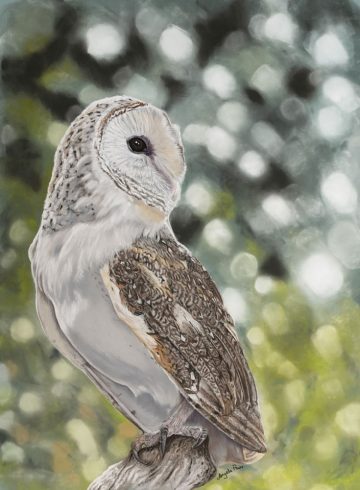
Socrates
Pastels ($POA)
60 cm H x 48 cm W
Barn owls live alone or in pairs and are excellent hunters, catching their prey in complete darkness, using super-sensitive hearing, and silent flight.
Being nocturnal, they roost quietly by day in unseen places like tree hollows, thickly foliaged trees, caves and rock crevices, buildings and even wells. As Australia is one of the world’s worst offenders when it comes to land clearing, with a projected 3 million hectares of untouched forest to be lost by 2030, one of the biggest threats to Australian owls is loss of habitat. Our owls rely on hollow-bearing trees, often hundreds of years old, for breeding.
As owls are natural predators of rodents, Rat Poison is fast becoming the biggest killers of owls, due to secondary killings. Owls also fall victim to vehicle strikes as they disperse in search of food when local prey populations begin to thin out, or drought conditions affect inland Australia.Read moreSocrates
Pastels ($POA)
60 cm H x 48 cm W
Barn owls live alone or in pairs and are excellent hunters, catching their prey in complete darkness, using super-sensitive hearing, and silent flight.
Being nocturnal, they roost quietly by day in unseen places like tree hollows, thickly foliaged trees, caves and rock crevices, buildings and even wells. As Australia is one of the world’s worst offenders when it comes to land clearing, with a projected 3 million hectares of untouched forest to be lost by 2030, one of the biggest threats to Australian owls is loss of habitat. Our owls rely on hollow-bearing trees, often hundreds of years old, for breeding.
As owls are natural predators of rodents, Rat Poison is fast becoming the biggest killers of owls, due to secondary killings. Owls also fall victim to vehicle strikes as they disperse in search of food when local prey populations begin to thin out, or drought conditions affect inland Australia.Quick View -

Back Off! She’s Mine!
Acrylic on Canvas (sold)
150 cm W x 180 cm H
Black cockatoos are my absolute favourite birds, and these three “yellow-tails” were a commission for a local family who had a large wall which needed a stunningly large artwork to feature on it.
They also have a beautiful flowering Corymbia Calophylla tree in their yard, which they requested to be incorporated into the composition. As it turns out they have two sons and a daughter, and by mere coincidence, I painted two male cockatoos (they have the pink rimmed eyes) and one female (grey rimmed eyes). My clients now feel the cockatoos represent their own three “golden” children. One could say it was a very successful commission for all involved. Limited Edition Prints are available, and as always a percentage of sales goes to the Byron Bay Wildlife Hospital.Read moreBack Off! She’s Mine!
Acrylic on Canvas (sold)
150 cm W x 180 cm H
Black cockatoos are my absolute favourite birds, and these three “yellow-tails” were a commission for a local family who had a large wall which needed a stunningly large artwork to feature on it.
They also have a beautiful flowering Corymbia Calophylla tree in their yard, which they requested to be incorporated into the composition. As it turns out they have two sons and a daughter, and by mere coincidence, I painted two male cockatoos (they have the pink rimmed eyes) and one female (grey rimmed eyes). My clients now feel the cockatoos represent their own three “golden” children. One could say it was a very successful commission for all involved. Limited Edition Prints are available, and as always a percentage of sales goes to the Byron Bay Wildlife Hospital.Quick View -

Girl Gang
Pastel on Pastelmat (Sold)
89 cm W x 63 cm H
Galahs (Eolophus roseicapilla) are one of the most abundant and familiar of the Australian parrots, occurring over most of the country, including some offshore islands. Galahs have a bouncing acrobatic flight, but spend much of the day sheltering from heat in the foliage of trees and shrubs. Huge noisy flocks of birds congregate and roost together at night. They are affectionate and friendly birds, with pairs mating for life. Female Galahs have red or pink eyes (the males have brown or black), so these are girls obviously hanging together for a good giggle.
Read moreGirl Gang
Pastel on Pastelmat (Sold)
89 cm W x 63 cm H
Galahs (Eolophus roseicapilla) are one of the most abundant and familiar of the Australian parrots, occurring over most of the country, including some offshore islands. Galahs have a bouncing acrobatic flight, but spend much of the day sheltering from heat in the foliage of trees and shrubs. Huge noisy flocks of birds congregate and roost together at night. They are affectionate and friendly birds, with pairs mating for life. Female Galahs have red or pink eyes (the males have brown or black), so these are girls obviously hanging together for a good giggle.
Quick View -

You’re Such a Show Off
Pastel on Pastelmat Board (sold)
94 cm W x 64 cm H
Black cockatoos are the biggest parrots in Australia, and these Yellow-Tails have been painted life size to illustrate just how large they really are. The male (pink eye rim) is a big show off, usually dancing around during breeding season to impress his mate, bopping his head like a rock star, and fluffing up his crest. But they are also very intelligent and loving, often bringing their mate gifts of food, singing to her and preening her feathers to show his affection. The female is less than impressed, often giving him a sharp peck to bring him into line. Hence my title. They mate for life, which can be over 50 years, but sadly they breed slowly, just two eggs, of which only one survives. The chick will stay with its parents for six months before becoming independent. The adult pair will remain together for life, caring tenderly for one another, even after reproductive age has ceased. Their distinctive screech is old bush lore indicating rain is coming, and I always love seeing their huge flocks fly over our property, screaming raucously. They are one of my favourite birds.Read moreYou’re Such a Show Off
Pastel on Pastelmat Board (sold)
94 cm W x 64 cm H
Black cockatoos are the biggest parrots in Australia, and these Yellow-Tails have been painted life size to illustrate just how large they really are. The male (pink eye rim) is a big show off, usually dancing around during breeding season to impress his mate, bopping his head like a rock star, and fluffing up his crest. But they are also very intelligent and loving, often bringing their mate gifts of food, singing to her and preening her feathers to show his affection. The female is less than impressed, often giving him a sharp peck to bring him into line. Hence my title. They mate for life, which can be over 50 years, but sadly they breed slowly, just two eggs, of which only one survives. The chick will stay with its parents for six months before becoming independent. The adult pair will remain together for life, caring tenderly for one another, even after reproductive age has ceased. Their distinctive screech is old bush lore indicating rain is coming, and I always love seeing their huge flocks fly over our property, screaming raucously. They are one of my favourite birds.Quick View -

Protecting Her Young
Pastel on Pastelmat (sold)
51 cm W x 71 cm H
An early morning drive on Kangaroo Island revealed Cape Barron Geese (Cereopsis novaehollandiae) grazing in the grassy clearing. A month later half of the island was burning, and I was concerned for this little flock. Cape Barron Geese were almost hunted to extinction in the 1900’s but numbers eventually restored to 20,000 on Australia’s southern islands. They are monogamous, bonding for life, and aggressively defend their clutches of 4-5 eggs. They are one of the world’s rarest geese. In my artwork I highlight their beautiful plumage, the adult’s defensive position over the vulnerable chicks, and hint at the imminent danger of fire.Read moreProtecting Her Young
Pastel on Pastelmat (sold)
51 cm W x 71 cm H
An early morning drive on Kangaroo Island revealed Cape Barron Geese (Cereopsis novaehollandiae) grazing in the grassy clearing. A month later half of the island was burning, and I was concerned for this little flock. Cape Barron Geese were almost hunted to extinction in the 1900’s but numbers eventually restored to 20,000 on Australia’s southern islands. They are monogamous, bonding for life, and aggressively defend their clutches of 4-5 eggs. They are one of the world’s rarest geese. In my artwork I highlight their beautiful plumage, the adult’s defensive position over the vulnerable chicks, and hint at the imminent danger of fire.Quick View -

A Keen Eye
Pastel on Pastelmat (Sold)
51 cm W x 67 cm H
The Laughing Kookaburra (Dacelo novaeguineae) is arguably the best-known and most loved bird of Australia with its highly distinctive raucous “laugh”. The loud ‘koo-koo-koo-koo-koo-kaa-kaa-kaa’ is however not really the kookaburra laughing but actually a territorial call to warn other birds to stay away. Laughing Kookaburras feed mostly on insects, worms and crustaceans, although small snakes, mammals, frogs and birds may also be eaten. Prey is espied and then seized by pouncing from a suitable perch, as shown in my artwork. Small prey is eaten whole, but larger prey is killed by bashing it against the ground or tree branch.Read moreA Keen Eye
Pastel on Pastelmat (Sold)
51 cm W x 67 cm H
The Laughing Kookaburra (Dacelo novaeguineae) is arguably the best-known and most loved bird of Australia with its highly distinctive raucous “laugh”. The loud ‘koo-koo-koo-koo-koo-kaa-kaa-kaa’ is however not really the kookaburra laughing but actually a territorial call to warn other birds to stay away. Laughing Kookaburras feed mostly on insects, worms and crustaceans, although small snakes, mammals, frogs and birds may also be eaten. Prey is espied and then seized by pouncing from a suitable perch, as shown in my artwork. Small prey is eaten whole, but larger prey is killed by bashing it against the ground or tree branch.Quick View -

The Bow Wave
Pastel on Pastelmat (Sold)
45 cm W x 45 cm H
Sunset on Lake Ainsworth at Lennox Head, and this Pacific Black Duck (Anas superciliosa) was hunting a final meal for the day. Their diet is mainly vegetarian, supplemented by small molluscs, crustaceans, and insects, not bread, which well-meaning but misinformed people often feed them. Due to their “commonness” ducks are often overlooked as subjects to paint, although they have obvious beauty. They are at risk from habitat loss and despite the strong evidence of the extreme suffering involved, four Australian states still allow recreational duck hunting. My artwork aims to draw attention to these ducks, becoming a conversation starter for their protection.Read moreThe Bow Wave
Pastel on Pastelmat (Sold)
45 cm W x 45 cm H
Sunset on Lake Ainsworth at Lennox Head, and this Pacific Black Duck (Anas superciliosa) was hunting a final meal for the day. Their diet is mainly vegetarian, supplemented by small molluscs, crustaceans, and insects, not bread, which well-meaning but misinformed people often feed them. Due to their “commonness” ducks are often overlooked as subjects to paint, although they have obvious beauty. They are at risk from habitat loss and despite the strong evidence of the extreme suffering involved, four Australian states still allow recreational duck hunting. My artwork aims to draw attention to these ducks, becoming a conversation starter for their protection.Quick View -

A Split Second
Pastel on Pastelmat Board (Sold)
48 cm W x 38 cm H
Adult male Superb Fairy-wrens (Malurus cyaneus) are among the most brightly coloured of the species, especially during the breeding season. These ‘coloured’ males are often accompanied by a band of brown ‘jenny wrens’, assumed to be a harem of females, but often include immature males which have not yet attained their breeding plumage. Seen in most habitat types where suitable dense cover and low shrubs occur, including urban parks and gardens, they can be seen in small social groups. These groups normally consist of one male and several females and young birds. They feed on insects and other small arthropods, which are caught mostly on the ground, but may also be taken from low bushes. This artwork depicts a male in the waning evening light about to launch on unsuspecting prey.Read moreA Split Second
Pastel on Pastelmat Board (Sold)
48 cm W x 38 cm H
Adult male Superb Fairy-wrens (Malurus cyaneus) are among the most brightly coloured of the species, especially during the breeding season. These ‘coloured’ males are often accompanied by a band of brown ‘jenny wrens’, assumed to be a harem of females, but often include immature males which have not yet attained their breeding plumage. Seen in most habitat types where suitable dense cover and low shrubs occur, including urban parks and gardens, they can be seen in small social groups. These groups normally consist of one male and several females and young birds. They feed on insects and other small arthropods, which are caught mostly on the ground, but may also be taken from low bushes. This artwork depicts a male in the waning evening light about to launch on unsuspecting prey.Quick View -

Jabiru Dreaming
Pastel on Mi Tientes Tex ($POA)
41 cm W x 51 cm H
The Black-necked Stork (formerly referred to as the Jabiru) (Ephippiorhynchus asiaticusis) is Australia’s only native stork, with numbers at approximately 10,000 birds. They are threatened by habitat destruction, the draining of shallow wetlands, disturbance at nests, overfishing, pollution, collision with electricity wires and hunting. Several breeding pairs have recently been spotted as far south as the northern river areas of NSW, the Bundjalung area where I live. My father-in-law loves these birds and asked me to paint him one. Their black-neck name is misleading, as although their bodies are black and white, their necks shine a radiant glossy dark green and purple in the sunlight. They have a massive black bill and striking long coral-red legs. The males have black eyes whilst the female’s eye is yellow. This fellow is obviously a male and was hunting in the shallow waters of Chickiba Lake in Ballina, NSW.Read moreJabiru Dreaming
Pastel on Mi Tientes Tex ($POA)
41 cm W x 51 cm H
The Black-necked Stork (formerly referred to as the Jabiru) (Ephippiorhynchus asiaticusis) is Australia’s only native stork, with numbers at approximately 10,000 birds. They are threatened by habitat destruction, the draining of shallow wetlands, disturbance at nests, overfishing, pollution, collision with electricity wires and hunting. Several breeding pairs have recently been spotted as far south as the northern river areas of NSW, the Bundjalung area where I live. My father-in-law loves these birds and asked me to paint him one. Their black-neck name is misleading, as although their bodies are black and white, their necks shine a radiant glossy dark green and purple in the sunlight. They have a massive black bill and striking long coral-red legs. The males have black eyes whilst the female’s eye is yellow. This fellow is obviously a male and was hunting in the shallow waters of Chickiba Lake in Ballina, NSW.Quick View -

Just a Little to the Left
Pastel on Mi Tientes Tex (Sold)
45 cm W x 68 cm H
The Rainbow Lorikeet (Trichoglossus moluccanusis) is found in a wide range of treed habitats including rainforest and woodlands. It has also acclimatised well to urbanisation and is commonly encountered in well-treed suburbs. They are nectar and pollen feeders and if you look inside a lorikeet’s mouth, you’ll notice that their tongues have uniquely adapted “brushes” on the tips to help them harvest these foods from the plants in their environment. The Rainbow Lorikeet also eats fruits, seeds and some insects. Plant grevilleas and other native flowering bushes in your backyard to attract them, rather than offering honey-coated bread which is extremely unhealthy for them. They are colourful, noisy and cheeky by nature so it’s rare to see them in a quiet grooming pose such as this one.Read moreJust a Little to the Left
Pastel on Mi Tientes Tex (Sold)
45 cm W x 68 cm H
The Rainbow Lorikeet (Trichoglossus moluccanusis) is found in a wide range of treed habitats including rainforest and woodlands. It has also acclimatised well to urbanisation and is commonly encountered in well-treed suburbs. They are nectar and pollen feeders and if you look inside a lorikeet’s mouth, you’ll notice that their tongues have uniquely adapted “brushes” on the tips to help them harvest these foods from the plants in their environment. The Rainbow Lorikeet also eats fruits, seeds and some insects. Plant grevilleas and other native flowering bushes in your backyard to attract them, rather than offering honey-coated bread which is extremely unhealthy for them. They are colourful, noisy and cheeky by nature so it’s rare to see them in a quiet grooming pose such as this one.Quick View -

Little Boy Blue
Watercolour on board (Sold)
35 cm W x 30 cm H
Another Superb Fairy-Wren (Malurus cyaneus) this time outside of breeding season. It’s their sky blue-coloured caps, which become iridescent during breeding season. Much loved among Australians, the fairy-wren can be found all across south-east Australia and enjoys a shrubby understorey where they move about in small groups. New research has revealed that male fairy-wrens sing to their eggs and their chicks come out recognising their parent’s unique song. This small study made good use of a vibrant yellow background to really highlight the wren’s colouration.Read moreLittle Boy Blue
Watercolour on board (Sold)
35 cm W x 30 cm H
Another Superb Fairy-Wren (Malurus cyaneus) this time outside of breeding season. It’s their sky blue-coloured caps, which become iridescent during breeding season. Much loved among Australians, the fairy-wren can be found all across south-east Australia and enjoys a shrubby understorey where they move about in small groups. New research has revealed that male fairy-wrens sing to their eggs and their chicks come out recognising their parent’s unique song. This small study made good use of a vibrant yellow background to really highlight the wren’s colouration.Quick View -

Jonathan Soaring
Pastel on Mi Tientes Tex ($POA)
68 cm W x 88 cm H
I was obsessed with the book Jonathan Livingston Seagull during my youth and even named our son Fletcher after one of the characters in Richard Bach’s fable novella. The common Silver Gull (Chroicocephalus novaehollandiae) is easily the most recognisable of all seagulls, although sadly it is also widely castigated as a voracious and persistent scavenger. The saying “Like a seagull on a hot chip” speaks of this characteristic. Their kleptoparasitic behaviour, and explosion in numbers since the 1950’s is due to the large quantities of food waste that Australians now produce. Their “natural diet” includes worms, fish, insects, and crustaceans. They are a clean and attractive bird and to see them soaring on the coastal breezes, like this one is doing, reminds us of how stunning they really are.Read moreJonathan Soaring
Pastel on Mi Tientes Tex ($POA)
68 cm W x 88 cm H
I was obsessed with the book Jonathan Livingston Seagull during my youth and even named our son Fletcher after one of the characters in Richard Bach’s fable novella. The common Silver Gull (Chroicocephalus novaehollandiae) is easily the most recognisable of all seagulls, although sadly it is also widely castigated as a voracious and persistent scavenger. The saying “Like a seagull on a hot chip” speaks of this characteristic. Their kleptoparasitic behaviour, and explosion in numbers since the 1950’s is due to the large quantities of food waste that Australians now produce. Their “natural diet” includes worms, fish, insects, and crustaceans. They are a clean and attractive bird and to see them soaring on the coastal breezes, like this one is doing, reminds us of how stunning they really are.Quick View -

Ponderings
Pastel on Pastelmat (Sold)
63 cm W x 83 cm H
My hometown has an abundance of Australian pelicans (Pelecanus conspicillatus), and in fact the Australia Seabird Rescue was founded and based here through the conservation work of a wonderful man Lance Ferris, whom locals affectionately knew as “The Pelican Man”. Lance’s work started in 1992 after he noticed many pelicans injured by fishing line and hooks. Pelicans were rescued, rehabilitated, and released. His work soon extended from pelicans to other coastal birds as well as marine turtles. As I was involved in Bird Rehabilitation myself at the time, I often crossed paths with Lance. He was passionate about educating the community, especially school children and fisher-folk, to preserve and protect the coastal environment and all marine wildlife. Australian Seabird Rescue (one of my chosen charities) now works around Australia to protect and rescue seabirds and shorebirds. Seeing pelicans serenely gliding along our waterways, still gives me great delight.Read morePonderings
Pastel on Pastelmat (Sold)
63 cm W x 83 cm H
My hometown has an abundance of Australian pelicans (Pelecanus conspicillatus), and in fact the Australia Seabird Rescue was founded and based here through the conservation work of a wonderful man Lance Ferris, whom locals affectionately knew as “The Pelican Man”. Lance’s work started in 1992 after he noticed many pelicans injured by fishing line and hooks. Pelicans were rescued, rehabilitated, and released. His work soon extended from pelicans to other coastal birds as well as marine turtles. As I was involved in Bird Rehabilitation myself at the time, I often crossed paths with Lance. He was passionate about educating the community, especially school children and fisher-folk, to preserve and protect the coastal environment and all marine wildlife. Australian Seabird Rescue (one of my chosen charities) now works around Australia to protect and rescue seabirds and shorebirds. Seeing pelicans serenely gliding along our waterways, still gives me great delight.Quick View -

Rainbows Take Flight
Pastel on Pastelmat board ($POA)
94 cm W x 54 cm H
Loud, belligerent colonies of rainbow lorikeets (Trichoglossus moluccanus) are the soundtrack of urban Australia. They are often seen in fast-moving screeching flocks or gathering in huge, noisy numbers inhabiting large blossoming trees in local parks or backyards. The noise can be deafening. In many places, including campsites and suburban gardens, wild lorikeets are so used to humans that they can be hand-fed, although many people, ignorant of their dietary requirements, feed them bread or bread coated with honey. This is an inadequate source of the nutrients, vitamins and minerals that the rainbow lorikeet requires and can lead to health and feather formation issues in young lorikeets. Sadly, this is just another example of how human interaction can negatively affect our precious wildlife. I have created this artwork from a compilation of images, intending to show the rainbow lorikeets’ unmistakable patchwork of colours in a variety of flight positions and focus.Read moreRainbows Take Flight
Pastel on Pastelmat board ($POA)
94 cm W x 54 cm H
Loud, belligerent colonies of rainbow lorikeets (Trichoglossus moluccanus) are the soundtrack of urban Australia. They are often seen in fast-moving screeching flocks or gathering in huge, noisy numbers inhabiting large blossoming trees in local parks or backyards. The noise can be deafening. In many places, including campsites and suburban gardens, wild lorikeets are so used to humans that they can be hand-fed, although many people, ignorant of their dietary requirements, feed them bread or bread coated with honey. This is an inadequate source of the nutrients, vitamins and minerals that the rainbow lorikeet requires and can lead to health and feather formation issues in young lorikeets. Sadly, this is just another example of how human interaction can negatively affect our precious wildlife. I have created this artwork from a compilation of images, intending to show the rainbow lorikeets’ unmistakable patchwork of colours in a variety of flight positions and focus.Quick View -

Is This My Best Side?
Pastel on Pastelmat board ($POA)
55 cm W x 46 cm H
The green rosella or Tasmanian rosella (Platycercus caledonicus) is a species of parrot native to Tasmania and Bass Strait islands. Found in a wide range of habitats with some form of tree cover, the green rosella is predominantly herbivorous, consuming seeds, berries, nuts and fruit, as well as flowers, but may also eat insect larvae and insects such as psyllids. Their nesting site is usually a hollow over 1 m deep in a tree trunk anywhere up to 30 m above the ground. Chimneys, holes in walls and even the vertical pipes of tennis court fences have been used. Green rosellas nested in a wall cavity at Port Arthur convict prison site in 1958 and 2009, which is where this bird was spotted.Read moreIs This My Best Side?
Pastel on Pastelmat board ($POA)
55 cm W x 46 cm H
The green rosella or Tasmanian rosella (Platycercus caledonicus) is a species of parrot native to Tasmania and Bass Strait islands. Found in a wide range of habitats with some form of tree cover, the green rosella is predominantly herbivorous, consuming seeds, berries, nuts and fruit, as well as flowers, but may also eat insect larvae and insects such as psyllids. Their nesting site is usually a hollow over 1 m deep in a tree trunk anywhere up to 30 m above the ground. Chimneys, holes in walls and even the vertical pipes of tennis court fences have been used. Green rosellas nested in a wall cavity at Port Arthur convict prison site in 1958 and 2009, which is where this bird was spotted.Quick View -

A Bunch of Wags
Acrylic on canvas (Sold)
122 cm W x 122 cm H
Willy Wagtails (Rhipidura leucophrys) belong to the group of birds affectionately known in birding circles as the ‘Black and Whites’, our common backyard birds. They are small and engaging with their constant sideways wagging of their fantail which earned them the name wagtail. Willie Wagtails feature prominently in indigenous mythology and were disliked by Indigenous people in some areas, as they were thought to loiter at the edge of camps, listening to conversations then telling the secrets elsewhere. The Willie Wagtail was also seen as an ill omen, and they would abandon an expedition if a Willie Wagtail was seen on the morning of departure. This artwork depicts their chattering nature almost as though they are telling each other off, or perhaps sharing THAT secret!Read moreA Bunch of Wags
Acrylic on canvas (Sold)
122 cm W x 122 cm H
Willy Wagtails (Rhipidura leucophrys) belong to the group of birds affectionately known in birding circles as the ‘Black and Whites’, our common backyard birds. They are small and engaging with their constant sideways wagging of their fantail which earned them the name wagtail. Willie Wagtails feature prominently in indigenous mythology and were disliked by Indigenous people in some areas, as they were thought to loiter at the edge of camps, listening to conversations then telling the secrets elsewhere. The Willie Wagtail was also seen as an ill omen, and they would abandon an expedition if a Willie Wagtail was seen on the morning of departure. This artwork depicts their chattering nature almost as though they are telling each other off, or perhaps sharing THAT secret!Quick View -
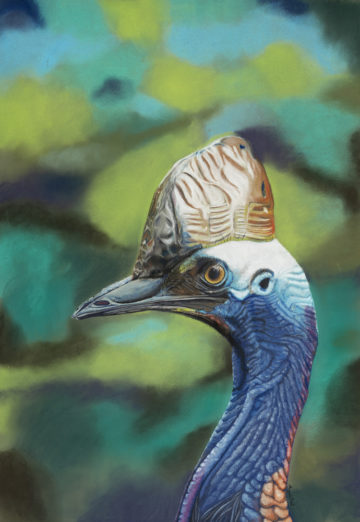
Wrinkles
Pastel on Canson paper (Sold)
47 cm W x 66 cm H
“Wrinkles” lives in the Daintree in far north Queensland, along with other Southern Cassowaries, (Casuarius casuarius). They are an icon of tourism in this area, but sadly are now endangered due to habitat loss, and threats from motor vehicles, dog packs, feral pigs and disease. Cassowaries are integral for the health of our Tropical rainforests due to seed dispersal of between 70 to 100 plant species. It is vital that this bird’s unique future is secured. Cassowaries have striking colours and “helmets” known as casques and I hoped to give homage to this in my pastel rendition.Read moreWrinkles
Pastel on Canson paper (Sold)
47 cm W x 66 cm H
“Wrinkles” lives in the Daintree in far north Queensland, along with other Southern Cassowaries, (Casuarius casuarius). They are an icon of tourism in this area, but sadly are now endangered due to habitat loss, and threats from motor vehicles, dog packs, feral pigs and disease. Cassowaries are integral for the health of our Tropical rainforests due to seed dispersal of between 70 to 100 plant species. It is vital that this bird’s unique future is secured. Cassowaries have striking colours and “helmets” known as casques and I hoped to give homage to this in my pastel rendition.Quick View -

A Breezy Perch
Pastel on Canson paper (Sold)
86 cm W x 60 cm H
The galah (Eolophus roseicapilla), also known as the pink and grey cockatoo or rose-breasted cockatoo, is among the most common of the cockatoos. With its distinctive pink and grey plumage and its bold and loud behaviour, it is a familiar sight in the wild and increasingly in urban areas. Like other cockatoos, the Galah is an excellent mimic of voices and sounds. Add this to their bright colour and hilarious personalities, as they are often seen hanging upside-down on a telegraph line, bobbing their heads in a dance, or playing soccer with pebbles on the ground, you will understand why ‘galah’ is Aussie slang for a silly person. The galah is often found in flocks of 10 to 1,000 individuals, and rarely is it seen on its own like this one enjoying the country breeze on a typical outback fence.Read moreA Breezy Perch
Pastel on Canson paper (Sold)
86 cm W x 60 cm H
The galah (Eolophus roseicapilla), also known as the pink and grey cockatoo or rose-breasted cockatoo, is among the most common of the cockatoos. With its distinctive pink and grey plumage and its bold and loud behaviour, it is a familiar sight in the wild and increasingly in urban areas. Like other cockatoos, the Galah is an excellent mimic of voices and sounds. Add this to their bright colour and hilarious personalities, as they are often seen hanging upside-down on a telegraph line, bobbing their heads in a dance, or playing soccer with pebbles on the ground, you will understand why ‘galah’ is Aussie slang for a silly person. The galah is often found in flocks of 10 to 1,000 individuals, and rarely is it seen on its own like this one enjoying the country breeze on a typical outback fence.Quick View -
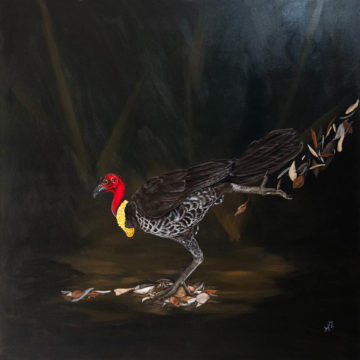
A Brush with Death
Acrylic on canvas (sold)
122 cm W x 122 cm H
Never has a bird so divided the opinions of visitors coming to my gallery as this Brush Turkey. The Australian Brush Turkey (Alectura lathami), also known as the bush or scrub turkey, has a bad reputation. They are blamed for damaging gardens (making an awful mess as it digs up leaf litter, twigs and dirt to build its egg mound) and darting across roads. Found in eastern Australia from Far North Queensland to the Illawarra in New South Wales, they’ve managed to adapt to life in cities and have also been introduced to Kangaroo Island in South Australia. Brush turkey nests or ‘mounds’ are the size of a car and are made up of soil and plant material. Built by the males to attract a mate, they’re essentially large compost heaps, that take the hard-working male about a month to create.
These mounds generate a huge amount of heat and that’s what incubates the eggs — which is lucky because once the eggs are laid the mother is off, and the father only sticks around to defend the mound. When the chicks have left the nest, the leftover mound is a perfect bit of compost for humans to spread out over the garden.Read moreA Brush with Death
Acrylic on canvas (sold)
122 cm W x 122 cm H
Never has a bird so divided the opinions of visitors coming to my gallery as this Brush Turkey. The Australian Brush Turkey (Alectura lathami), also known as the bush or scrub turkey, has a bad reputation. They are blamed for damaging gardens (making an awful mess as it digs up leaf litter, twigs and dirt to build its egg mound) and darting across roads. Found in eastern Australia from Far North Queensland to the Illawarra in New South Wales, they’ve managed to adapt to life in cities and have also been introduced to Kangaroo Island in South Australia. Brush turkey nests or ‘mounds’ are the size of a car and are made up of soil and plant material. Built by the males to attract a mate, they’re essentially large compost heaps, that take the hard-working male about a month to create.
These mounds generate a huge amount of heat and that’s what incubates the eggs — which is lucky because once the eggs are laid the mother is off, and the father only sticks around to defend the mound. When the chicks have left the nest, the leftover mound is a perfect bit of compost for humans to spread out over the garden.Quick View -

A Miner Squabble
Acrylic on canvas (Sold)
122 cm W x 122 cm H
When my children were much younger, they used to stand in our front yard waiting for the morning school bus. A tree there was usually alive with squabbling Noisy Miner birds (Manorina melanocephala) expressing ritualised displays, such as flight displays, postural displays, and facial displays. Noisy miners are particularly pugnacious honeyeaters, gregarious, bold, curious and territorial; they forage, bathe, roost, breed and defend territory communally, forming colonies that can contain several hundred birds. Each bird has an ‘activity space’, and birds with overlapping activity spaces form associations called ‘coteries’, which are the most stable units within the colony. The birds also form temporary flocks called ‘coalitions’ for specific activities, such as mobbing a predator. The noisy miner is a notably aggressive bird, so that chasing, pecking, fighting, scolding, and mobbing occur throughout the day, targeted at both intruders and colony members.Read moreA Miner Squabble
Acrylic on canvas (Sold)
122 cm W x 122 cm H
When my children were much younger, they used to stand in our front yard waiting for the morning school bus. A tree there was usually alive with squabbling Noisy Miner birds (Manorina melanocephala) expressing ritualised displays, such as flight displays, postural displays, and facial displays. Noisy miners are particularly pugnacious honeyeaters, gregarious, bold, curious and territorial; they forage, bathe, roost, breed and defend territory communally, forming colonies that can contain several hundred birds. Each bird has an ‘activity space’, and birds with overlapping activity spaces form associations called ‘coteries’, which are the most stable units within the colony. The birds also form temporary flocks called ‘coalitions’ for specific activities, such as mobbing a predator. The noisy miner is a notably aggressive bird, so that chasing, pecking, fighting, scolding, and mobbing occur throughout the day, targeted at both intruders and colony members.Quick View -

A Nest of Spoons
Pastel on Mi Tientes Tex ($POA)
87 cm W x 67 cm H
A juvenile Royal Spoonbill (Platalea regia) arrived on our property, lost and starving. We fed little “Teaspoon” the Christmas Prawn scraps before finding a suitable wetland nearby for relocation.
“Teaspoon’s” visit made me curious about Spoonbills. They are found throughout eastern and northern Australia, residing in wetlands, mudflats and grasslands. Their black spatulate bill contains papillae (vibration detectors) which help them “feel” for prey in murky water, day or night.
In breeding season the birds are very white, with a distinctive ‘nuchal’ crest on the head/neck. A yellow patch is above the eye, absent in juveniles, who are often ‘dirty’ in appearance.Read moreA Nest of Spoons
Pastel on Mi Tientes Tex ($POA)
87 cm W x 67 cm H
A juvenile Royal Spoonbill (Platalea regia) arrived on our property, lost and starving. We fed little “Teaspoon” the Christmas Prawn scraps before finding a suitable wetland nearby for relocation.
“Teaspoon’s” visit made me curious about Spoonbills. They are found throughout eastern and northern Australia, residing in wetlands, mudflats and grasslands. Their black spatulate bill contains papillae (vibration detectors) which help them “feel” for prey in murky water, day or night.
In breeding season the birds are very white, with a distinctive ‘nuchal’ crest on the head/neck. A yellow patch is above the eye, absent in juveniles, who are often ‘dirty’ in appearance.Quick View -
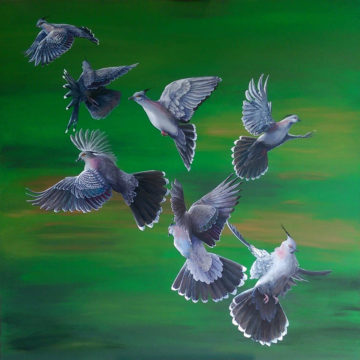
An Uprising
Acrylic on canvas (Sold)
122 cm W x 122 cm H
This painting was one of 8 large canvases that formed the basis of my “Avian Criminals and Other Fine Feathered Friends” exhibition held in 2017 in the Northern Rivers Community Gallery. Each large canvas had a strong background colour and the birds painted thereon were given names that hinted at some kind of rebellion or misdeed. The Crested Pigeons (Ocyphaps lophotes) in this painting were chosen because of the whirring sound they make when they rise in fright from the ground. The source of the noise can be attributed to the way the air rushes over a modified primary feather found on the wings. This is most likely to draw the attention of predators to birds on the wing, and away from any birds remaining on the ground, and as an alarm call to other pigeons.Read moreAn Uprising
Acrylic on canvas (Sold)
122 cm W x 122 cm H
This painting was one of 8 large canvases that formed the basis of my “Avian Criminals and Other Fine Feathered Friends” exhibition held in 2017 in the Northern Rivers Community Gallery. Each large canvas had a strong background colour and the birds painted thereon were given names that hinted at some kind of rebellion or misdeed. The Crested Pigeons (Ocyphaps lophotes) in this painting were chosen because of the whirring sound they make when they rise in fright from the ground. The source of the noise can be attributed to the way the air rushes over a modified primary feather found on the wings. This is most likely to draw the attention of predators to birds on the wing, and away from any birds remaining on the ground, and as an alarm call to other pigeons.Quick View -

The Thin White Line
Watercolour on board (Sold)
90 cm W x 71 cm H
I used to own a studio out of town and driving there one day I found a freshly killed beautiful Tawny Frogmouth (Podargus strigoides) that appeared to have been just hit by a vehicle that passed through a few minutes before me. There wasn’t a mark on the body, and as it was just too lovely to discard, I decided to take it to my studio and immortalise it in an artwork. The background is both the road with it’s white dividing line and heaven to which the bird is ascending. Hence the title which also implies the fragile line between life and death.Read moreThe Thin White Line
Watercolour on board (Sold)
90 cm W x 71 cm H
I used to own a studio out of town and driving there one day I found a freshly killed beautiful Tawny Frogmouth (Podargus strigoides) that appeared to have been just hit by a vehicle that passed through a few minutes before me. There wasn’t a mark on the body, and as it was just too lovely to discard, I decided to take it to my studio and immortalise it in an artwork. The background is both the road with it’s white dividing line and heaven to which the bird is ascending. Hence the title which also implies the fragile line between life and death.Quick View -

The Mob
Acrylic on canvas (Sold)
122 cm W x 122 cm H
Another of my “Avian Criminal” pieces, this study of “tough guy” Australian magpies (Cracticus tibicen) has the large bird Marlon (as in Brando fame) surrounded by the rest of his “mob”. All the birds are exhibiting that haughty, intense stare magpies are renowned for. Apart from its widespread distribution — there are few places in Australia where magpies do not occur — the species’ familiarity is probably due equally to its pleasant carolling song, which is such an essential part of the Australian soundscape, and for its tendency to swoop at people during its springtime nesting season. The poles the magpies are perched on were modelled upon poles that had been newly erected at a nearby beach and were instantly recognised by the locals.Read moreThe Mob
Acrylic on canvas (Sold)
122 cm W x 122 cm H
Another of my “Avian Criminal” pieces, this study of “tough guy” Australian magpies (Cracticus tibicen) has the large bird Marlon (as in Brando fame) surrounded by the rest of his “mob”. All the birds are exhibiting that haughty, intense stare magpies are renowned for. Apart from its widespread distribution — there are few places in Australia where magpies do not occur — the species’ familiarity is probably due equally to its pleasant carolling song, which is such an essential part of the Australian soundscape, and for its tendency to swoop at people during its springtime nesting season. The poles the magpies are perched on were modelled upon poles that had been newly erected at a nearby beach and were instantly recognised by the locals.Quick View -

The Observer
Pastel on Pastelmat (Sold)
46 cm W x 66 cm H
The Eastern Osprey (Pandion cristatus) is a familiar sight on the Ballina/Byron coastline, so I was surprised to learn its status is “vulnerable” in NSW. Osprey often return to the same nest, so habitat destruction and disturbance often disrupts nesting. Discarded fishing tackle, contaminated fish, polluted waterways and electrocution from nesting on powerline poles also pose serious threats. Fortunately, our council has erected several Osprey Breeding Platforms and I am accustomed to see them circling the skies, hear them whistle to each other, and in breeding season, see little fluff balls peek over the nest’s edge. They are a majestic bird.Read moreThe Observer
Pastel on Pastelmat (Sold)
46 cm W x 66 cm H
The Eastern Osprey (Pandion cristatus) is a familiar sight on the Ballina/Byron coastline, so I was surprised to learn its status is “vulnerable” in NSW. Osprey often return to the same nest, so habitat destruction and disturbance often disrupts nesting. Discarded fishing tackle, contaminated fish, polluted waterways and electrocution from nesting on powerline poles also pose serious threats. Fortunately, our council has erected several Osprey Breeding Platforms and I am accustomed to see them circling the skies, hear them whistle to each other, and in breeding season, see little fluff balls peek over the nest’s edge. They are a majestic bird.Quick View -

Peregrine Falcon
Watercolour on Arches paper ($POA)
49 cm W x 68 cm H
The peregrine falcon (Falco peregrinus) is the world’s most widespread raptor found nearly everywhere on Earth, except extreme polar regions, very high mountains, and most tropical rainforests. The peregrine is renowned for its speed, reaching over 320 km/h during its characteristic hunting stoop (high-speed dive), making it the fastest bird in the world, and the fastest member of the animal kingdom. Although its diet consists almost exclusively of medium-sized birds, the peregrine will sometimes hunt small mammals, small reptiles, or even insects. Reaching sexual maturity at one year, it mates for life and nests in a scrape, normally on cliff edges or, in recent times, on tall human-made structures. Since 1991, a pair of Peregrine Falcons has been observed in a nest on the rooftop of 367 Collins Street. As home to the only known peregrine falcon nesting site within Melbourne’s CBD, the building plays a surprisingly important role to the ongoing breeding success of these rare and fiercely territorial birds. The magnificent specimen in my artwork was recovering from injury in a raptor sanctuary before being released back into the wild.Read morePeregrine Falcon
Watercolour on Arches paper ($POA)
49 cm W x 68 cm H
The peregrine falcon (Falco peregrinus) is the world’s most widespread raptor found nearly everywhere on Earth, except extreme polar regions, very high mountains, and most tropical rainforests. The peregrine is renowned for its speed, reaching over 320 km/h during its characteristic hunting stoop (high-speed dive), making it the fastest bird in the world, and the fastest member of the animal kingdom. Although its diet consists almost exclusively of medium-sized birds, the peregrine will sometimes hunt small mammals, small reptiles, or even insects. Reaching sexual maturity at one year, it mates for life and nests in a scrape, normally on cliff edges or, in recent times, on tall human-made structures. Since 1991, a pair of Peregrine Falcons has been observed in a nest on the rooftop of 367 Collins Street. As home to the only known peregrine falcon nesting site within Melbourne’s CBD, the building plays a surprisingly important role to the ongoing breeding success of these rare and fiercely territorial birds. The magnificent specimen in my artwork was recovering from injury in a raptor sanctuary before being released back into the wild.Quick View -

Aquila Audax
Watercolour and coloured pencil on Arches paper ($POA)
76 cm W x 60 cm H
The wedge-tailed eagle (Aquila audax) is the largest bird of prey in Australia, with an impressive wing span of up to 2.84 m and a body length up to 1.06 m. Females weigh between 3-6kg , whilst males are slightly lighter at 2-4kg. Wedge-tailed eagles are highly aerial, soaring for hours on end without wingbeat and seemingly without effort, regularly reaching 1,800 m. Most prey is captured on the ground in gliding attacks. Choice of prey include the introduced rabbit and brown hare, (their diet of choice) foxes and feral cats, native wallabies, small kangaroos, possums, wombats, koalas, and bandicoots. In some areas, birds and reptiles may also be taken. “Wedgies” have also been known to team up to hunt large red kangaroos, to cause goats to fall off steep hillsides and injure themselves, or to drive flocks of sheep or kangaroos to isolate a weaker animal.Read moreAquila Audax
Watercolour and coloured pencil on Arches paper ($POA)
76 cm W x 60 cm H
The wedge-tailed eagle (Aquila audax) is the largest bird of prey in Australia, with an impressive wing span of up to 2.84 m and a body length up to 1.06 m. Females weigh between 3-6kg , whilst males are slightly lighter at 2-4kg. Wedge-tailed eagles are highly aerial, soaring for hours on end without wingbeat and seemingly without effort, regularly reaching 1,800 m. Most prey is captured on the ground in gliding attacks. Choice of prey include the introduced rabbit and brown hare, (their diet of choice) foxes and feral cats, native wallabies, small kangaroos, possums, wombats, koalas, and bandicoots. In some areas, birds and reptiles may also be taken. “Wedgies” have also been known to team up to hunt large red kangaroos, to cause goats to fall off steep hillsides and injure themselves, or to drive flocks of sheep or kangaroos to isolate a weaker animal.Quick View -
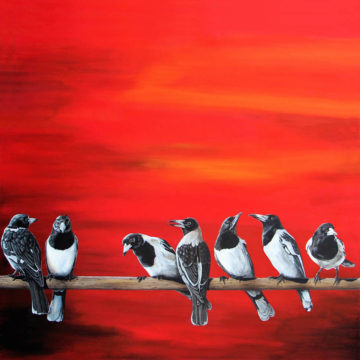
Butchers
Acrylic on canvas (Sold)
122 cm W x 122 cm H
The striking red background in this “Avian Criminal” piece hints strongly at the blood thirsty nature of the pied butcherbird (Cracticus nigrogularis) due to its habit of sometimes storing food items by impaling them on a stick or on barbed wire or shoving them in a nook or crevice. In ironic contrast the pied butcherbird has been considered the most accomplished songbird in Australia, its song described as a “magic flute”. Song melodies vary across the continent and no single song is sung by the whole population. There is no clear demarcation between simple calls and elaborate songs: duets, and even larger choirs, are common. The species improvises extensively in creating new and complex melodies. One of its calls has been likened to the opening bars of Beethoven’s Fifth Symphony. Singing often takes place at dawn, rarely late in the day, but sometimes on moonlit nights.Read moreButchers
Acrylic on canvas (Sold)
122 cm W x 122 cm H
The striking red background in this “Avian Criminal” piece hints strongly at the blood thirsty nature of the pied butcherbird (Cracticus nigrogularis) due to its habit of sometimes storing food items by impaling them on a stick or on barbed wire or shoving them in a nook or crevice. In ironic contrast the pied butcherbird has been considered the most accomplished songbird in Australia, its song described as a “magic flute”. Song melodies vary across the continent and no single song is sung by the whole population. There is no clear demarcation between simple calls and elaborate songs: duets, and even larger choirs, are common. The species improvises extensively in creating new and complex melodies. One of its calls has been likened to the opening bars of Beethoven’s Fifth Symphony. Singing often takes place at dawn, rarely late in the day, but sometimes on moonlit nights.Quick View -

King of Fishers
Pastel on Canson paper (Sold)
50 cm W x 65 cm H
Australia has 10 native species of kingfishers, including the kookaburra, which is the largest. Kingfishers nest in tree hollows, in burrows in riverbanks and in termite nests. They feed on small animals, including fish, frogs, yabbies, snakes, insects and nestlings of other birds. Some kingfishers were once in danger of being hunted to extinction for their feathers. Despite their elaborate garb, these stocky birds are tough, and hunt by darting upon prey in a flash of colour from branches above the river or forest floor. The kingfisher’s heavy beak is the perfect tool for despatching victims quickly – they smack their hapless prey against tree branches before swallowing them whole. This small Azure Kingfisher (Alcedo azurea) is a tiny 17cm in length, with a wingspan of 25-29cm.Read moreKing of Fishers
Pastel on Canson paper (Sold)
50 cm W x 65 cm H
Australia has 10 native species of kingfishers, including the kookaburra, which is the largest. Kingfishers nest in tree hollows, in burrows in riverbanks and in termite nests. They feed on small animals, including fish, frogs, yabbies, snakes, insects and nestlings of other birds. Some kingfishers were once in danger of being hunted to extinction for their feathers. Despite their elaborate garb, these stocky birds are tough, and hunt by darting upon prey in a flash of colour from branches above the river or forest floor. The kingfisher’s heavy beak is the perfect tool for despatching victims quickly – they smack their hapless prey against tree branches before swallowing them whole. This small Azure Kingfisher (Alcedo azurea) is a tiny 17cm in length, with a wingspan of 25-29cm.Quick View -
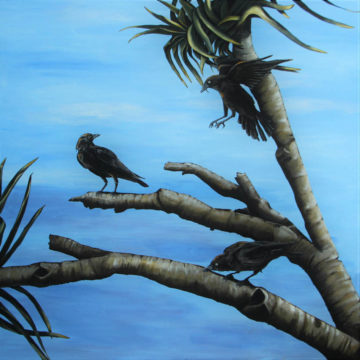
Murder
Acrylic on canvas (Sold)
122 cm W x 122 cm H
‘Murder’ was the first in my Avian series, based upon a scene that played out before me as I walked around a headland of my local beach. Torresian Crows (Corvus orru) were rising from and descending back to the Pandanus tree growing on the edge of the cliff, as the stiff wind aided their activity. The sky was gloomy and dark with an impending storm, and I thought to myself, there is a painting here begging to be actualised.Read moreMurder
Acrylic on canvas (Sold)
122 cm W x 122 cm H
‘Murder’ was the first in my Avian series, based upon a scene that played out before me as I walked around a headland of my local beach. Torresian Crows (Corvus orru) were rising from and descending back to the Pandanus tree growing on the edge of the cliff, as the stiff wind aided their activity. The sky was gloomy and dark with an impending storm, and I thought to myself, there is a painting here begging to be actualised.Quick View -

On the Watch
Ink on Arches paper (Sold)
48 cm W x 68 cm H
Kookaburras (Dacelo novaeguineae) are terrestrial tree kingfishers found in habitats ranging from humid forest to arid savannah, as well as in suburban areas with tall trees or near running water. Kookaburras are almost exclusively carnivorous, eating mice, snakes, insects, small reptiles, and the young of other birds; unlike many other kingfishers, they rarely eat fish, although they have been known to take goldfish from garden ponds. They often accept handouts and take meat from barbecues, but feeding kookaburras ground beef or pet food is not advised, as these do not include enough calcium and roughage for their health requirements.Read moreOn the Watch
Ink on Arches paper (Sold)
48 cm W x 68 cm H
Kookaburras (Dacelo novaeguineae) are terrestrial tree kingfishers found in habitats ranging from humid forest to arid savannah, as well as in suburban areas with tall trees or near running water. Kookaburras are almost exclusively carnivorous, eating mice, snakes, insects, small reptiles, and the young of other birds; unlike many other kingfishers, they rarely eat fish, although they have been known to take goldfish from garden ponds. They often accept handouts and take meat from barbecues, but feeding kookaburras ground beef or pet food is not advised, as these do not include enough calcium and roughage for their health requirements.Quick View -

Parliament Sits in Judgement
Acrylic on canvas (Sold)
122 cm W x 122 cm H
Yet another in the ‘Avian’ series, these Australian Boobook Owls (Ninox boobook), derived their name from their two-tone boo-book call. In some regions known as the mopoke, they are the smallest owl native to the Australian mainland. Using a fence, branch, or telegraph pole as a perch or vantage point from which to hunt, the Australian boobook pounces on prey then retreats to a tree or elevated place to eat it. It often hunts in open areas near trees, and also where prey is likely to congregate, such as mice near haystacks or barns, or flying insects near street- or house-lights.Read moreParliament Sits in Judgement
Acrylic on canvas (Sold)
122 cm W x 122 cm H
Yet another in the ‘Avian’ series, these Australian Boobook Owls (Ninox boobook), derived their name from their two-tone boo-book call. In some regions known as the mopoke, they are the smallest owl native to the Australian mainland. Using a fence, branch, or telegraph pole as a perch or vantage point from which to hunt, the Australian boobook pounces on prey then retreats to a tree or elevated place to eat it. It often hunts in open areas near trees, and also where prey is likely to congregate, such as mice near haystacks or barns, or flying insects near street- or house-lights.Quick View -

Pee Wee
Ink on Arches paper ($POA)
30 cm W x 23 cm H
When I used to do wildlife care, I often cared for orphaned and abandoned fledglings. Pee Wee was one of my success stories, being raised on mealworms, bugs and any other creepy crawlies I could procure for her. After she was old enough and took to the skies to go live independently, she would often return if I called out “Pee Wee” loudly enough for her to hear. This continued for several weeks before finally she never returned, presumably having made her own way into the world. Pee Wee was actually a magpie-lark, (Grallina cyanoleuca) often also known as the peewee, peewit or mudlark. The sexes are similar from a distance but easy to tell apart: the female has a white throat, the male a black throat and a white “eyebrow”.Read morePee Wee
Ink on Arches paper ($POA)
30 cm W x 23 cm H
When I used to do wildlife care, I often cared for orphaned and abandoned fledglings. Pee Wee was one of my success stories, being raised on mealworms, bugs and any other creepy crawlies I could procure for her. After she was old enough and took to the skies to go live independently, she would often return if I called out “Pee Wee” loudly enough for her to hear. This continued for several weeks before finally she never returned, presumably having made her own way into the world. Pee Wee was actually a magpie-lark, (Grallina cyanoleuca) often also known as the peewee, peewit or mudlark. The sexes are similar from a distance but easy to tell apart: the female has a white throat, the male a black throat and a white “eyebrow”.Quick View -

Pukeko
Pastel on Canson paper ($POA)
30 cm W x 36 cm H
Our dog was a very well behaved cattle dog who as a rule didn’t chase wildlife or birds, but there was something about the “pukeko” which drove her crazy. The Australasian swamphen (Porphyrio melanotus) is a species of swamphen occurring in eastern Indonesia, Papua New Guinea, Australia and New Zealand where it is known as the pukeko. They are a handsome bird of the wetlands, Conspicuous blue and black in colour with a gigantic red bill and forehead shield. They have large feet and white under tail feathers which they flick up and down when walking. They are very vocal, often making loud crowing calls and a range of other shorter squawks, including a single note squawk at night.Read morePukeko
Pastel on Canson paper ($POA)
30 cm W x 36 cm H
Our dog was a very well behaved cattle dog who as a rule didn’t chase wildlife or birds, but there was something about the “pukeko” which drove her crazy. The Australasian swamphen (Porphyrio melanotus) is a species of swamphen occurring in eastern Indonesia, Papua New Guinea, Australia and New Zealand where it is known as the pukeko. They are a handsome bird of the wetlands, Conspicuous blue and black in colour with a gigantic red bill and forehead shield. They have large feet and white under tail feathers which they flick up and down when walking. They are very vocal, often making loud crowing calls and a range of other shorter squawks, including a single note squawk at night.Quick View


